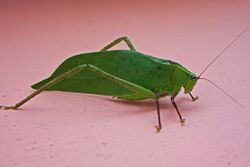Biology:Stilpnochlora
| Stilpnochlora | |
|---|---|

| |
| Stilpnochlora couloniana | |
| Scientific classification | |
| Domain: | Eukaryota |
| Kingdom: | Animalia |
| Phylum: | Arthropoda |
| Class: | Insecta |
| Order: | Orthoptera |
| Suborder: | Ensifera |
| Family: | Tettigoniidae |
| Genus: | Stilpnochlora Stål, 1873 |
Stilpnochlora is a genus of phaneropterine katydids in the family Tettigoniidae, native to tropical and subtropical parts of the Americas. There are about 15 described species in Stilpnochlora.[1][2][3][4]
They are relatively large, leaf-like katydids that are mostly green, between 5 and 10 cm (2–4 in) long depending on exact species, and females generally reach a larger size than males of the same species; S. couloniana is the largest katydid in the United States (no other member of the tribe Steirodontini occurs north of Mexico or the Caribbean islands).[5] Although some species in this genus have features that allow for relatively easy identification, several are very similar and can only be distinguished after a careful examination of certain morphological details (their distributions are often useful, too).[5] As far as known, Stilpnochlora and all other members of the tribe Steirodontini are entirely herbivorous.[5]
Species
These 15 species belong to the genus Stilpnochlora:[2][3]
References
- ↑ "Stilpnochlora Genus Information". https://bugguide.net/node/view/11842. Retrieved 2018-03-08.
- ↑ 2.0 2.1 "Stilpnochlora Overview". http://eol.org/pages/45948/overview. Retrieved 2018-03-08.
- ↑ 3.0 3.1 "Browse Stilpnochlora". http://www.catalogueoflife.org/col/browse/tree/id/17eb3477c98f77af4f82b6e8fe38f9d8. Retrieved 2018-03-08.
- ↑ Otte, Daniel; Cigliano, Maria Marta; Braun, Holger; Eades, David C.. "Orthoptera Species File Online". http://orthoptera.speciesfile.org/. Retrieved 2018-03-08.
- ↑ 5.0 5.1 5.2 Emsley, M.G. (1970). "A Revision of the Steirodontine Katydids (Orthoptera: Tettigoniidae: Phaneropterinae: Steirodontini)". Proceedings of the Academy of Natural Sciences of Philadelphia 122: 125-248.
Further reading
- Arnett, Ross H. Jr. (2000). American Insects: A Handbook of the Insects of America North of Mexico (2nd ed.). CRC Press. ISBN 0-8493-0212-9.
- Capinera, J.L; Scott, R.D.; Walker, T.J. (2004). Field Guide to Grasshoppers, Katydids, and Crickets of the United States. Cornell University Press. ISBN 978-0-8014-8948-8. https://archive.org/details/fieldguidetogras0000capi.
- Otte, Daniel (1997). Orthoptera. Nomina Insecta Nearctica: A Check List of the Insects of North America: vol. 4: Non-Holometabolous Orders. Entomological Information Services. pp. 581–634. ISBN 1-889002-04-6.
- "Singing Insects of North America". http://entnemdept.ufl.edu/Walker/buzz/. Retrieved 2018-03-08.
External links
Wikidata ☰ Q10680173 entry
 |

